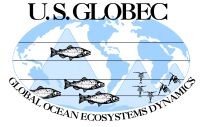
Questions and
Answers
__________
GLOBEC
International
__________
| GLOBEC Northeast Pacific Program Mapping of Physical and Biological Fields in the Northern California Current July 31 - August 19, 2002 |
 |
August 4, 2002 SeaSOAR continues 8:15 a.m.: A mild morning on the Revelle as we are East bound on line 8 of the mesoscale survey. A safety meeting was held this morning in the library/conference room to discuss deployment of additional drifters and the start of the CTD casts which will take place in a few days.
12:00 p.m. : This image shows the approximate position of the
Revelle at 12 p.m. today. The Blue-green line represents the
path of ship as it completes the mesoscale survey. Also
shown is the path from 3 of the drifters that were previously
deployed. 1:30 p.m.: The SeaSOAR is operated by a three person team that is on watch during a 4 hour period. On the Revelle the teams consist of Marc Willis, Chad Waluk, Renato Castelao; Bob O'Malley, Anatoli Evofeev, Di Wu; Linda Fayler, Toby Martin, and Meng Zhou. Even though the SeaSOAR is on a software controlled auto-pilot it requires constant attention especially in shallow water where it may come within 10 meters of the ocean floor. Obstructions in the water, especially crab pots, are watched carefully and sometimes cannot be avoided as was the case on August 1. Even as the SeaSOAR is in the water the data is being analyzed and processed. The SeaSOAR is an instrument package that is able to measure several different things at the same time. Mounted below the SeaSOAR is the Optical Particle Counter (OPC). The OPC allows water to pass through a light beam that is aimed at a sensor. Not only the number but the size of the particles can be measured and recorded. On top of the SeaSOAR are other sensors that make measurements of the amount of chlorophyll and particles in the water and the amount of light that is penetrating down from the surface of the ocean. Inside is the CTD instrument that measures conductivity, temperature, density, and the salinity of the water. Towing the SeaSOAR is an armored cable that contains optical fibers and copper wires that supply electricity to and return data from the instruments. Power for the SeaSOAR wings comes from an impeller on the back that drives an internal hydraulic system controlled from the ship.
6:30 p.m.: The crew is enjoying a nice pleasant evening off
Cape Blanco viewing the lighthouse. Fingers are crossed that the
nice weather will continue until the end of the mesoscale survey 2
days from now. .jpg) .jpg)
|
This page was last updated on August 05, 2002 02:42 PM
.jpg)
.jpg)
.gif)
.jpg)
.jpg)
.jpg)
.jpg)
.jpg)


